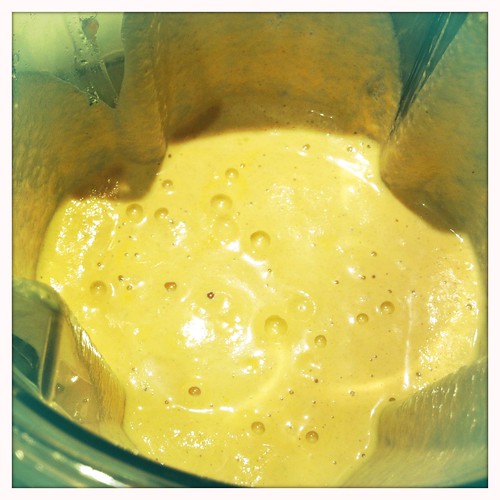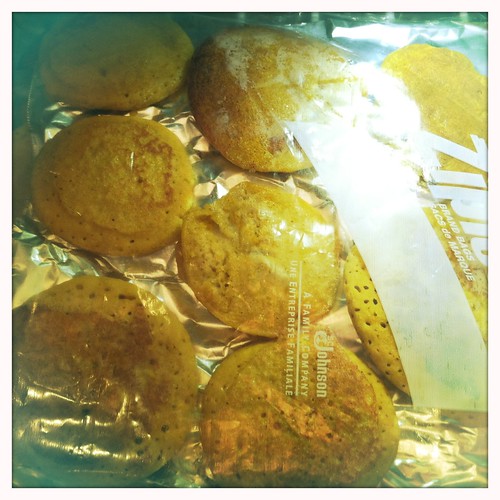I couldn't even get a good picture of this using the wonder that is Hipstamatic - probably because by using I mean shaking my iPhone to get the next random lens-whatever combo and taking pictures from several angles until I get a photo that actually includes the desired subject (as opposed to my messy counter in the background, for instance) and is at least semi-in-focus.

Regardless of lackluster photo though, this soup is WONDERFUL, so I had to post about it so you could all make it asap. The acidity of the tomatoes and lemon juice, sweetness of the red peppers, creaminess of the coconut milk, and super flavorful combination of fennel and basil all give this soup an unexpected complexity, stepping it up from your run-of-the-mill red pepper "bisque". And I didn't even roast my own peppers. (But you can if you want. How-to is at the end of this post, from Simply Recipes.)
Fennel and Roasted Red Pepper Soup
Yield: 6 servings
2 tablespoons oil or butter (I used coconut oil)
1 small bulb fennel, or half a large one (or a whole large one if you LOVE fennel), finely chopped
4 cloves garlic, sliced thin
1 teaspoon aleppo pepper flakes (optional)
1 teaspoon ground ginger (optional)
1 teaspoon salt, divided
1 15-oz jar roasted red peppers, coarsely chopped (or 4-5 red bell peppers, roasted)
1 28-oz can tomatoes, with juices (or 2 lbs fresh tomatoes, coarsely chopped)
2 14.5-oz cans coconut milk (not "lite" kind)
2 cups vegetable broth or chicken broth
2 cups water
1/2 cup minced fresh basil
Juice from half a lemon (~2 tablespoons)
In a large soup pot, heat oil, then add fennel and 1/4 teaspoon salt and sauté until just tender. Add garlic, aleppo pepper, ginger and 1/4 teaspoon salt and sauté until fragrant, about 1-2 minutes more. Add coconut milk, broth, water, red peppers, tomatoes, and remaining 1/2 teaspoon salt. Bring to boil, lower heat and simmer for 20-25 minutes, covered, stirring occasionally. Remove from heat. Using an immersion blender (or using an upright blender, doing 2 cups at a time), purée the soup to get as smooth a consistency as you can. Stir in basil, return pot to burner and cook over low heat for 2-3 minutes. Stir in lemon juice. Taste and add salt and pepper if desired.
How to Roast Red Peppers
From Simply Recipes
1. If you are canning for shelf storage (and not just chilling in the refrigerator), place a steaming rack at the bottom of a large (12-qt) pot, fill half way with water, bring to a boil. It takes a while to get a large pot of water to boil, so while the water is heating, proceed with the recipe.
2a. Broiler Method Position rack in oven so that the top surface of bell peppers placed in the oven will be 4-5 inches from the broiler heat element. Rub the surface of the peppers with a little olive oil (this will help them blister faster). Preheat broiler on high. Place peppers either directly on the top oven rack, with a pan to catch the drippings on a rack beneath, or place on a aluminum-foil or Silpat lined broiler pan (a cookie sheet will warp). As the surface of the peppers blister and blacken, turn them with tongs so that they will blacken on all sides.
2b. Stovetop Method If you have a gas range (or grill) you can place the peppers directly on the range top so that the flames lick the peppers. Work carefully so that as soon as one section of a pepper is blackened, you turn it to work on a fresh side. If you have an electric stove, heat a cast iron pan on high and place the peppers in the pan, allowing the peel to blister and blacken, turning so that all sides get blackened.
3. When the peppers are all well blistered and blackened, place in a non-reactive bowl and cover, or put them in a paper bag and roll the bag shut. (The steam from the hot peppers will help dislodge the skins.) Once the peppers have cooled enough to handle, work with them one by one over a plate, gently peel off the blackened skins. Cut the peppers in half and remove and discard the seed pods, stems and all seeds.




















